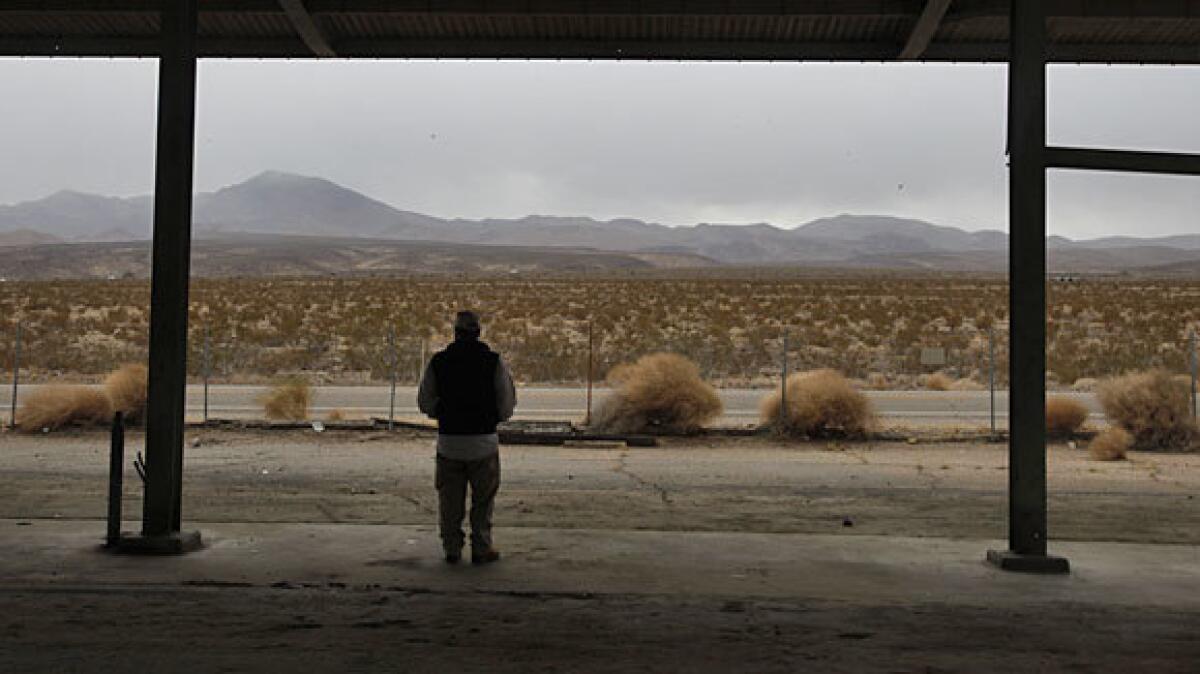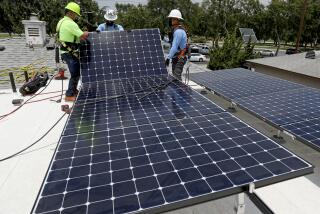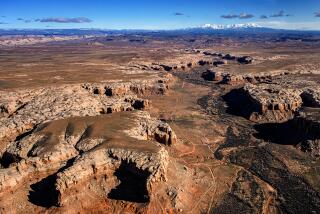Land speculators see silver lining in solar projects

For Sale: 3,400 acres in the desert.
• No paved roads. Check.
• Isolated. Ideal.
• Land not suitable for farming. Perfect.
• Blistering sunshine. Jackpot.
• Asking price: $34 million. Deal.
As large-scale solar development has spooled out into Southwestern deserts, the modern-day gold rush is about more than renewable energy. Solar companies and land speculators are gobbling up scarce private land in the California deserts, driving prices up 10- to 20-fold, or even higher.
Desolate acreage that a few years ago might have sold for less than $500 an acre can now fetch as much as $20,000 an acre, according to land brokers in the region. Farmers are also getting in on the action. Alfalfa and cotton fields are being converted to solar and wind farms as the industry’s big players put together mega-deals.
“It’s mind-boggling what’s happening,” said Jean Laborde of Bakersfield, a former farmer who has been selling agricultural land in the Mojave and adjacent Colorado deserts for 45 years.
Laborde has made a killing lately. About 10 years ago, one of his clients listed 750 barren acres near the town of Mojave, but Laborde couldn’t sell it. He finally bought the land himself for $350 an acre. “There’s no water, the wind blows all the time,” he said. “Everyone said this was a Godforsaken place.”
Laborde held on to the property, then sold it a few years ago to someone who intended to build a solar power plant. Laborde won’t disclose what the developer paid, but the price today would be $10,000 an acre, he said. “Turned out to be the best deal I ever made.”
Real estate specialists warn that not all desert landowners will enjoy a similar payday, but try telling that to old-timers who hear about deals that have turned farmers into millionaires. A recent example is the family of alfalfa growers in Gila Bend, Ariz., who sold 3,000 acres of cropland to a consortium of investors, who then sold the land to Spanish solar giant Abengoa for $45 million.
Earlier this year Ari Swiller, who heads aLos Angeles-based renewable energy company, quietly gathered up 11,000 acres near Blythe — the largest aggregation of separate parcels the Riverside County assessor’s office has seen in 15 years. Although the property hasn’t been resold, Riverside County Assessor Larry W. Ward said land in the area that typically sells in “the low hundreds” per acre is now going for $2,000 to $3,000 an acre.
That part of the state offers what solar developers require: mostly flat land near transmission lines, and reliable sunshine. Depending on the size of the plant, companies may need a few hundred or a few thousand acres.
Most of the utility-scale solar farms sprouting in the desert are on federal land, which companies lease for a nominal yearly rate. But some developers prefer private property, even at high prices, because public land carries a thick sediment of bureaucracy: a snarl of federal and state environmental laws that requires time-consuming and expensive analysis before the first shovel of dirt is turned.
Private land carries few similar impediments. As long as the parcel holds no cultural resources or protected species, a solar developer can move quickly and avoid costly construction delays.
Solar companies covet private land for another reason. If a renewable energy project on public or private property compromises habitat for endangered species, the developer must buy biologically suitable private land to account for that loss. The Ivanpah Solar Project, for example, requires that Oakland-based developer BrightSource buy 7,000 acres to replace habitat for the threatened desert tortoise.
Solar companies are reluctant to speak publicly about land prices, partly out of fear that they will inflame an already overheated market. Developers try to fly beneath the real estate radar, often buying contiguous parcels under different names or through third parties to avoid igniting a land rush.
Most hire brokers or land scouts who bump along dirt roads trolling for cheap land. They, too, operate quietly and seldom disclose whom they represent.
John Reeder, a land broker with Sperry Van Ness in Ontario, said the market has spawned speculators, “investors who have purchased or control options on land, whose only plan was to sell to a solar company.”
The high-priced sales have longtime landowners salivating. But despite the talk of a land rush, most are still waiting to score.
In 1948, Russ Roberts’ great-grandfather bought 565 acres of desert scrub near Baker. Roberts said his ancestor was convinced that with the growth of Las Vegas, land along the highway from Los Angeles would become prized.
The gamble hasn’t really paid off for Roberts’ family, although now, with renewable energy developers calling, they have hope. The family is asking $7,000 an acre.
“We get a lot of tire-kickers,” Roberts said. “Calls from big companies in Germany. Nothing solid yet, though.”
Bobby Miller handled the $45-million transaction in Gila Bend, a farming outpost in the Sonoran Desert southwest of Phoenix. But he is dismissive of the idea that everyone with a few acres of dusty ground is going to get rich selling to big solar.
“The sale gave everyone the hope that their parcels would be like this,” said Miller, who has trademarked the nickname “Dr. Dirt” and has the seen-it-all weariness of someone who has surfed dozens of boom and bust cycles. “I think they are dreaming. I can sell you lots of bulk acreage at $800 an acre.”
Other real estate specialists warn that many sales collapse at the last minute as solar developers find that their projects don’t pencil out, often because government incentives or power purchase agreements don’t come through.
To meet the exceptionally high front-end costs, solar developers are dependent on federal loan guarantees, tax rebates and other subsidies to finance construction of multibillion-dollar solar plants. Renewable energy subsidies have been accelerated by the Obama administration, and the land-buying frenzy is in part caused by the approaching end of some federal incentives.
The complexities involved in solar projects have made for an uncertain market. Larry Cullinane, who has been selling land near Hesperia since 1975, estimated that 90% of all solar land deals fall apart in the first year, leaving the seller to start over with little more than a deposit.
“One of my clients has had close to $200 million fall out of solar contracts for various reasons,” he said. “In most cases it’s a financial scenario. Some of the owners get fed up with dealing with the solar developers.”
Buyers, too, have reason for skepticism. As California homeowners know from painful experience, runaway real estate prices carry a risk. Prices have risen so sharply and sales have been so spotty that establishing the true value of raw desert land is difficult.
Cullinane said two of his clients, brothers in their 80s, own 640 acres they have farmed and grazed since 1940. The men bought the property for $10,000, and are today asking $3.5 million.
The plot is good for solar, but it is 21/2 miles from the nearest transmission line. Cullinane thinks the price is about double its true value — although a naive buyer or a speculator might think otherwise.
Cullinane and some of his peers in the Mojave have also spotted a niche in the solar market: desert tortoise mitigation land. Cullinane now judges land according to how suitable it would be to relocate the tortoise. Class 1 mitigation land goes for $1,200 an acre, he said, while the best-quality habitat might bring $3,000 to $5,000 an acre.
“Just in the Mojave, I’ve got 20,000 acres, and in Kern County I’ve got about 15,000 acres for potential mitigation property,” Cullinane said.
If large-scale solar projects continue to proliferate in the heart of the tortoise habitat, and with companies required to find two to three acres of habitat for each acre they displace, a reasonable question becomes whether enough private land exists in the Southern California desert to cover the loss.
Less than 17% of the Mojave’s 20 million acres is private property.
Janine Blaeloch, director of the Western Lands Project, calls this the elephant in the room of the tortoise mitigation program.
“Just take a look — there just isn’t enough land for them to find and buy,” she said. “It’s the fatal flaw.”
Los Angeles Times researcher Maloy Moore contributed to this report.
THE SOLAR DESERT / One in a series of occasional articles chronicling the wide-ranging effects on the West of the emerging solar-energy industry.
More to Read
Start your day right
Sign up for Essential California for news, features and recommendations from the L.A. Times and beyond in your inbox six days a week.
You may occasionally receive promotional content from the Los Angeles Times.







